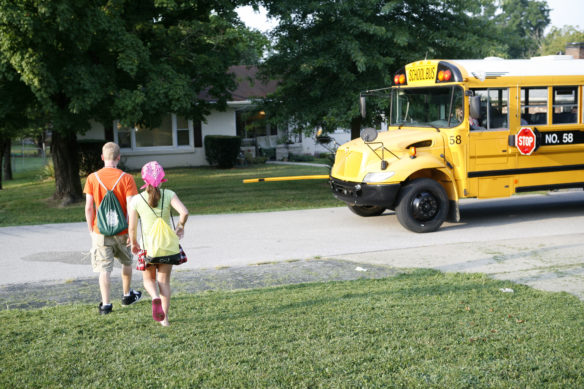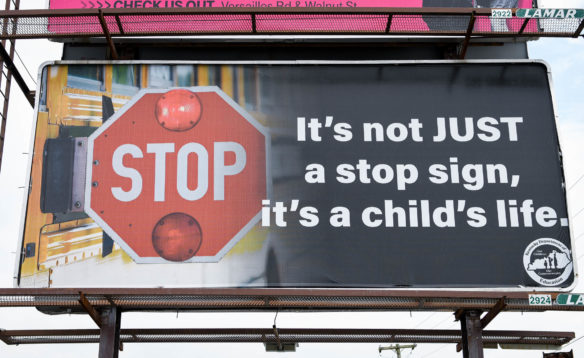
Kentucky Department of Education officials say illegal passing of school buses remains a big problem in the state. A one-day count of illegal passing in April showed 304 illegal school bus passes in 34 of Kentucky’s 173 school districts.
Photo by Amy Wallot
By Brenna R. Kelly
Brenna.kelly@education.ky.gov
On a single day this past April, more than 304 motorists in Kentucky ignored a school bus’s red, flashing stop sign and drove around the bus.
Each one of those illegal passes put a child at risk, said Elisa Hanley, pupil transportation supervisor at the Kentucky Department of Education.
“It’s just like our billboards say, ‘It’s not just a stop sign, it’s a child’s life,’” she said. “Bus drivers can only do so much from inside the bus; we need the public’s help in being aware of the danger. Any time there are flashing lights there’s probably a child getting on or off the bus.”
The actual number of illegal school bus passes in Kentucky on April 26 – the day of a national survey of illegal school bus passing – was likely much higher. Just 34 of the state’s 173 school districts participated, Hanley said.
It was the first time Kentucky participated in the one-day count coordinated by the National Association of State Directors of Pupil Transportation Services (NASDPTS). Observers on more than 1,264 Kentucky school buses recorded the passes.
2017 KDE Survey of Illegal Passing of School Buses
| Local Education Agency/County | Number of Participating Bus Drivers | Number of Vehicles Illegally Passing School Buses |
|---|---|---|
| Allen | 38 | 3 |
| Bardstown Independent | 16 | 13 |
| Bracken | 8 | 3 |
| Breathitt | 31 | 2 |
| Breckinridge | 52 | 4 |
| Caldwell | 29 | 0 |
| Caverna Independent | 7 | 1 |
| Danville Independent | 13 | 1 |
| Daviess | 81 | 31 |
| Eminence Independent | 3 | 1 |
| Floyd | 65 | 18 |
| Garrard | 41 | 6 |
| Green | 26 | 2 |
| Greenup | 39 | 1 |
| Hopkins | 66 | 1 |
| Jessamine | 104 | 19 |
| Kenton | 61 | 61 |
| Laurel | 10 | 12 |
| Livingston | 25 | 0 |
| Lyon | 13 | 0 |
| McCracken | 54 | 23 |
| Mercer | 41 | 15 |
| Montgomery | 23 | 15 |
| Oldham | 53 | 7 |
| Owensboro Independent | 22 | 0 |
| Paintsville Independent | 5 | 2 |
| Perry | 10 | 10 |
| Rowan | 40 | 13 |
| Science Hill Independent | 3 | 0 |
| Somerset Independent | 12 | 9 |
| Trigg | 31 | 6 |
| Walton-Verona Independent | 14 | 13 |
| Warren | 190 | 3 |
| Woodford | 38 | 7 |
| Totals | 1,264 | 304 |
Even with less than 20 percent of the state’s school district’s participating, the survey results confirm what school bus drivers and pupil transportation directors have known for years, Hanley said.
“Illegal passing of school buses is just a huge problem,” she said.
National School Bus Safety Week, which this year is Oct. 16-20, puts the public’s focus on school buses for a short time. For KDE, school districts and law enforcement, it’s an everyday job to make the ride to and from school safe for Kentucky’s 385,000 students.
In Kentucky, it is illegal to pass a stopped school bus in either direction on a two-lane road when the bus’s warning lights are on. When the bus’s lights flash and the stop arm extends, children are getting on or off the bus, Hanley said.
This fall 51 billboards across the state warned of the danger of passing a stopped school bus. The billboards, which were sponsored by KDE and first used in 2016, show a stop sign extended from the side of a school bus with the words, “It’s not JUST a stop sign, it’s a child’s life.”
“It is paramount that our children arrive at school and back home safely each day,” said Commissioner of Education Stephen Pruitt. “While stopping for a school bus might be a minor inconvenience for drivers, the penalty for passing a stopped school bus can be severe. Drivers can receive a fine, but for a child, it could be a matter of life or death.”
Under state law, drivers who pass a stopped school bus could face up to a $200 fine and or 60 days in jail. For a second offense within three years, the fine increases to $500 and up to six months in jail. Drivers also get six points off their license.
But prosecuting drivers is often difficult, Hanley said. Many police departments fail to pursue charges even when a school bus driver is able to record a passing car’s license plate number.
“Many law enforcement officers say, ‘I didn’t see it, I can’t charge it,’” she said. And even when a driver is charged, the cases are often dismissed, she said.
During the 2016-17 school year, 272 drivers in Kentucky were charged with passing a loading or unloading school bus, according to the Kentucky Administrative Office of the Courts (AOC). However, nearly half of those cases – 49.4 percent – were dismissed.

This fall, 51 billboards across the state warned of the danger of passing a stopped school bus. The billboards were sponsored by KDE and first used in 2016.
Photo by Bobby Ellis
That’s not the case in Warren County, said John Odom, Warren County Schools’ pupil transportation director. For more than 10 years, the district has worked with the Warren County Sheriff’s Office, Bowling Green Police and Warren County Attorney’s Office to successfully prosecute violators.
District bus drivers use a form created by law enforcement that allows them to quickly record the details of a passing car. Drivers circle the color of the car, whether the driver was male or female and fill in the license plate number.
The district keeps a copy and law enforcement gets a copy. After an officer investigates, which takes about a week, the county attorney’s office prepares an affidavit for the bus driver to sign, Odom said.
“They really go after these people,” Odom said. “We do enough advertisements and public affairs things that by now people should know that you don’t run stop arms and what the law is.”
During the 2016-17 school year, 80 percent of people charged with passing a bus in Warren County were convicted, according to AOC. Those 20 drivers paid a total of $875 in fines, the report showed. Bowling Green Independent also uses the same form and process.
“We still have a lot of stop arm violations,” Odom said. But before the forms and cooperation, the district recorded more than 250 violations a year, last year the district recorded about 80.
Bus drivers have learned where violations are likely to occur, he said. At one of those locations last school year, a student was about to get off the bus when a car passed on the right hand side.
“If the driver hadn’t been paying attention and pulled the student back on the bus …,” Odom said, falling to finish his sentence. That driver was prosecuted after the bus’s camera captured the license plate of the car, he said.
This school year, the district had only seen only six violations by mid-September, a decrease over the same time last year, Odom said.
“The prosecutions have made a difference,” he said. “But one is too many.”
Kenton County, in northern Kentucky, uses a different approach, said Kim Banta, assistant superintendent for the district, which serves about 14,000 students.
“Our problem is that we have so many different police departments that it is impossible for us to organize something that every police department is going to use,” Banta said.
In Kenton County, a school bus driver could drive through more than 12 jurisdictions on any given day. During the past school year, just two people in the county were charged with passing a stopped bus, both charges were dismissed, according to the AOC. So instead the district works to educate both the public and school bus drivers about the problem.
“Our goal is not necessarily to say, ‘I got you.’ Our goal is to try and prevent it from happening so no one gets hurt,” Banta said.
Bus drivers do call in over the radio to report illegal passes when they see them, she said.
“A driver can tell you exactly where they get a lot of passes,” she said. “So what the driver will do is educate the child and say, ‘Do not go until I tell you.’ They may hold the child in the bus until they see what the car is going to do.”
Before the buses hit the road for the new school year the district works with the local television stations to make residents aware of the dangers of passing a bus, Banta said. The district has created awareness campaigns – such as a car deodorizer that says “Stop on red, save a life” – and worked with KDE to put the stop sign billboards near locations with frequent violations.
This year, Kenton County is also one of three participating in a KDE program to put LED lights on the back of school buses. Called a driver alert device, it warn drivers that the bus is stopping with LED lights on the back door reading, “Caution, stopping.” The lights then read “Stop” and “Do not pass.”
“I think it’s going to be great,” Banta said. “It’s just another thing to catch people’s attention. People are impatient and everybody wants to get somewhere fast. It’s just not worth it to risk it.”
Fayette and Warren County schools also are participating in the pilot. Each district will receive four signs.
“We’ll put them on our routes that we know are the worst for illegal passes,” Odom said.
The districts will track whether the number of illegal passes decrease with the use of the lights, Hanley said. If the program is successful, the lights could be placed on buses across the state, she said.
The alert lights are also expected to reduce rear-end collisions because they make drivers more aware that the bus is preparing to stop. Last October, an SUV hit three Jefferson County students at their bus stop when the vehicle swerved to the right of the bus to avoid hitting its rear.
“School buses are equipped with multiple brake and warning lights, which should help prevent rear-end collisions,” Hanley said. “But distracted driving and being in a rush often results in some of the most preventable accidents.”
In the 2016-17 school year there were 185 rear-end collisions with Kentucky school buses, she said.
KDE also has resources on its website for schools, districts, parents and motorists who want to learn more about school bus safety. Many districts have student drivers take a pledge not to pass school buses before being allowed to drive to campus, Hanley said. KDE also has worked the Transportation Cabinet and Kentucky State Police to spread the word for motorists to watch out for buses when school begins.
“We’re trying to come at it from every angle,” Hanley said. “We want to make a difference. Every time someone illegally passes a school bus, it could mean a child’s life.”
MORE INFO …
Elisa Hanley Elisa.Hanley@education.ky.gov
John Odom John.Odom@Warren.kyschools.us
Kim Banta Kim.Banta@Kenton.kyschools.us



Leave A Comment